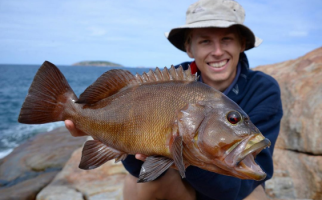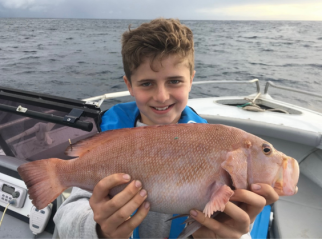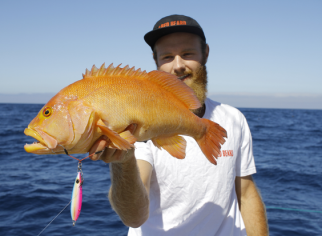Breaksea cod
Epinephelides armatus
Eating: 4.5 stars
ID – Dark black blotch around anus. Colour can vary including orange, brown and grey.
Breaksea cod, long known by another colloquial name that I won’t repeat here, are a staple for bottom fishers in the southern half of the State.
To me, they actually look a bit like the freshwater sooty grunter of the Kimberley, with their rather non-descript reddish/brownish/amber colouration. Fish in shallower water tend to be brownish, while those in deeper water can be more orange.

Breaksea cod are found from Shark Bay to Esperance, and are usually an inshore fish caught mostly in depths to 70m, although they have been known to be found in 150m.
They are a plain looking fish, but don’t let that fool you. They are only cod of the genus epinephelides, so they are a unique fish. Males grow large and faster than females, with a maximum size of around 55cm and three kilos.
They are usually caught by offshore anglers, but in recent years have also become a fairly regular shore-based capture. Intrepid shore anglers like Chris Dixon and Gideon Mettam are among the high-profile members of a growing band of rock fishers who claim some amazing land-based captures, and that includes quite a few breaksea cod.

Not being a regular offshore bottom fisher these days I don’t encounter too many breaksea, but on a recent trip out of Cheynes Beach with local caravan park owner Alan Marsh, he caught a couple of the biggest specimens I have seen.
Breaksea like to hang around structure and are rarely specifically targeted, but their aggressive predatory nature means they invariably feature regularly in catches of bottom fish. Unfortunately for them, they don’t handle changes of depth well at all and invariably come to the surface with severe barotrauma, making releasing them usually impossible.
They are excellent eating, so keeping them is not usually a problem for offshore fishers. The bag limit on the west coast is two, and three on the south coast.
As they are usually a bycatch while chasing other species, there is no best way to target breaksea really. However, the usual methods for bottom fishing, such as baited paternoster right, will produce them. They are also partial to lures fished near the bottom, such as soft plastics and metal jigs. Those who catch lots of breaksea believe that fresh squid is the prime bait for them.
